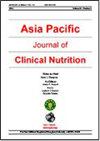美国成人叶酸摄入与非酒精性脂肪肝
IF 1.3
4区 医学
Q4 NUTRITION & DIETETICS
Asia Pacific journal of clinical nutrition
Pub Date : 2023-01-01
DOI:10.6133/apjcn.202303_32(1).0019
引用次数: 0
摘要
背景和目的:膳食叶酸摄入量与非酒精性脂肪性肝病(NAFLD)之间的关系是有争议的。本研究旨在调查美国成年人膳食叶酸当量(DFE)摄入量与NAFLD之间的关系。方法与研究设计:采用2007-2014年美国国家健康与营养调查(NHANES)的数据。NAFLD定义为美国脂肪肝指数(FLI)≥30。通过两次24小时饮食回忆访谈评估DFE摄入量。采用多变量logistic回归模型和限制三次样条模型来研究DFE摄入量与NAFLD风险之间的关系。结果:本研究共纳入6603名成人受试者。在对多个混杂因素进行调整后,DFE摄入量最高四分位数与最低四分位数NAFLD的比值比和95%置信区间为0.77(0.59-0.99)。在性别、年龄和体重指数(BMI)的分层分析中,在女性和BMI≥25的参与者中,DFE摄入量与NAFLD风险之间存在统计学上显著的负相关。剂量-反应分析显示DFE摄入量与NAFLD风险呈负线性相关。结论:在美国普通成年人中,膳食叶酸当量摄入量与NAFLD风险呈负相关。本文章由计算机程序翻译,如有差异,请以英文原文为准。
Folate intake and non-alcoholic fatty liver disease in US adults.
BACKGROUND AND OBJECTIVES The relationship between dietary folate intake and non-alcoholic fatty liver disease (NAFLD) is controversial. This study aimed to investigate the relationship between dietary folate equivalent (DFE) intake and NAFLD in U.S. adults. METHODS AND STUDY DESIGN Data from the National Health and Nutrition Examination Survey (NHANES) 2007-2014 were used. NAFLD was defined as a US fatty liver index (FLI) value ≥30. DFE intake was assessed by two 24-hour dietary recall interviews. Multivariable logistic regression models and restricted cubic spline models were used to investigate the association between DFE intake and NAFLD risk. RESULTS A total of 6,603 adult participants were included in this study. After adjusting for multiple confounding factors, the odds ratios and 95% confidence intervals of NAFLD for the highest quartile versus lowest quartile of DFE intake was 0.77(0.59-0.99). In stratified analyses by sex, age, and body mass index (BMI), there were statistically significant negative associations between DFE intake and NAFLD risk in women and participants with BMI ≥25. Dose-response analysis indicated a negative linear correlation between DFE intake and NAFLD risk. CONCLUSIONS Dietary folate equivalent intake is negatively associated with NAFLD risk in the general U.S. adult population.
求助全文
通过发布文献求助,成功后即可免费获取论文全文。
去求助
来源期刊
CiteScore
2.50
自引率
7.70%
发文量
58
审稿时长
6-12 weeks
期刊介绍:
The aims of the Asia Pacific Journal of Clinical Nutrition
(APJCN) are to publish high quality clinical nutrition relevant research findings which can build the capacity of
clinical nutritionists in the region and enhance the practice of human nutrition and related disciplines for health
promotion and disease prevention. APJCN will publish
original research reports, reviews, short communications
and case reports. News, book reviews and other items will
also be included. The acceptance criteria for all papers are
the quality and originality of the research and its significance to our readership. Except where otherwise stated,
manuscripts are peer-reviewed by at least two anonymous
reviewers and the Editor. The Editorial Board reserves the
right to refuse any material for publication and advises
that authors should retain copies of submitted manuscripts
and correspondence as material cannot be returned. Final
acceptance or rejection rests with the Editorial Board

 求助内容:
求助内容: 应助结果提醒方式:
应助结果提醒方式:


